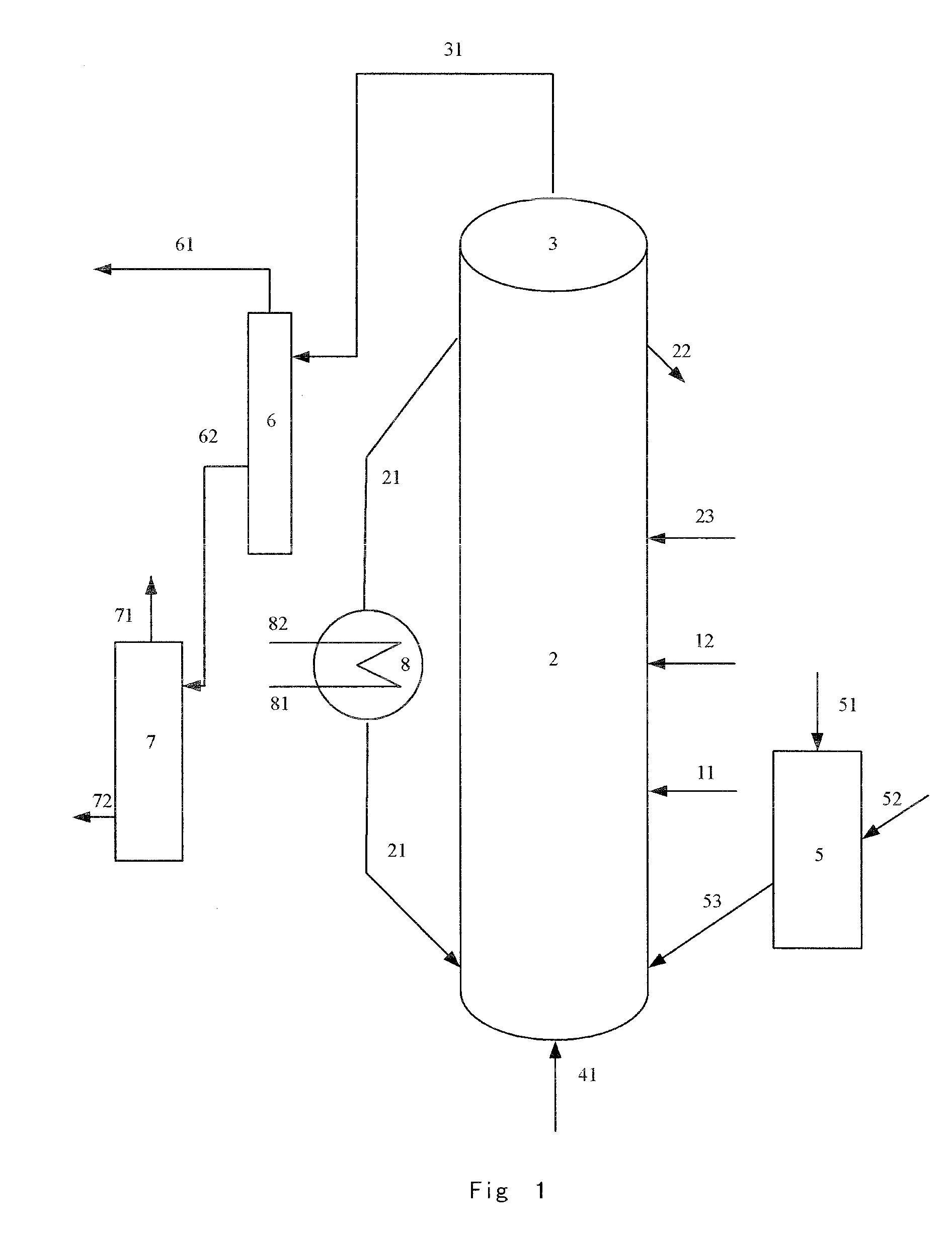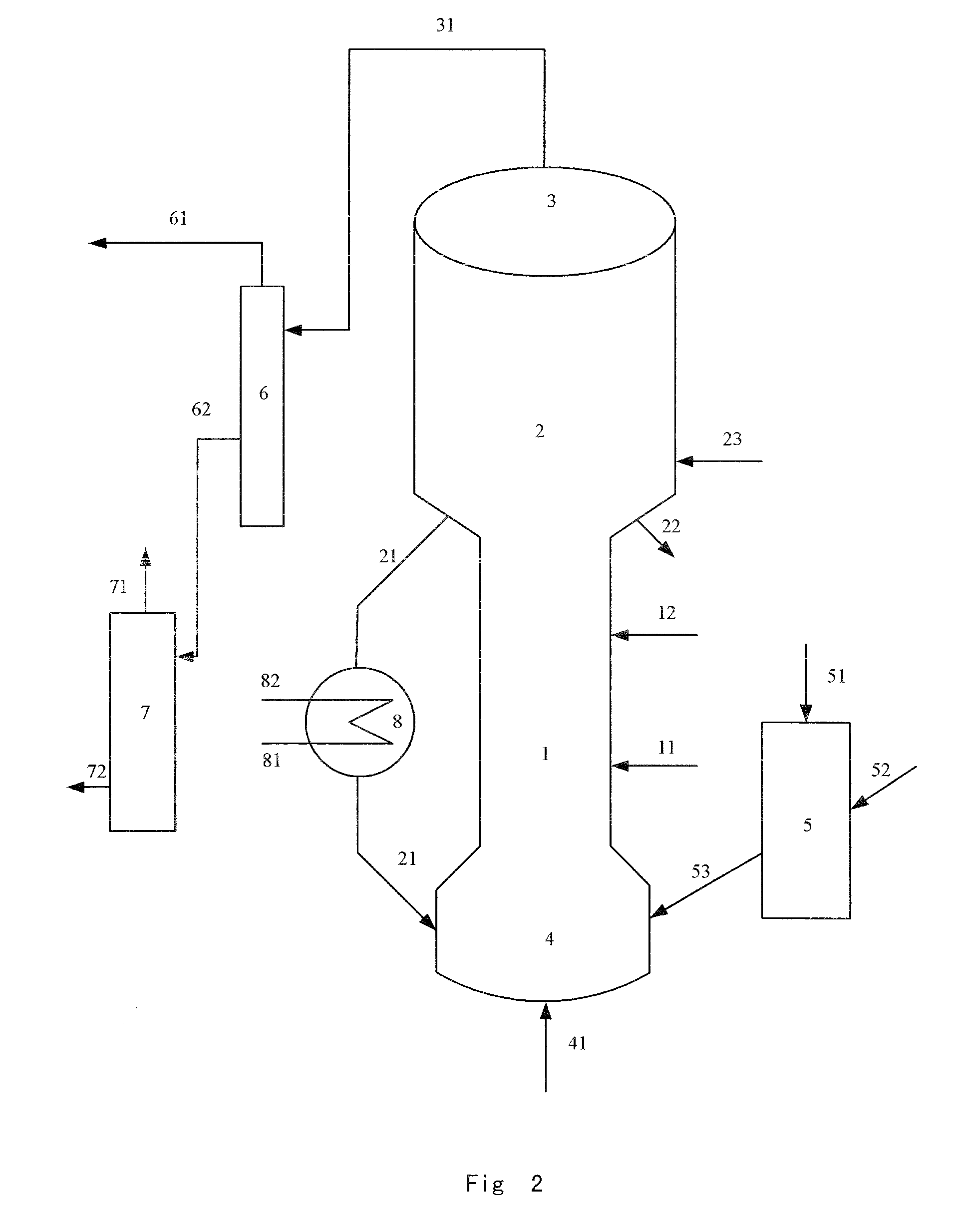Fluidized catalytic process for production of dimethyl ether from methanol
a technology of dimethyl ether and catalytic process, which is applied in the direction of physical/chemical process catalysts, ether preparation by compound dehydration, ether preparation, etc., can solve the problem of large increase of device investment and operating cost, small production scale of process, and pyrolysis reaction of methanol to produce much non-condensable gases, etc. problem, to achieve the effect of increasing the catalyst replacement ra
- Summary
- Abstract
- Description
- Claims
- Application Information
AI Technical Summary
Benefits of technology
Problems solved by technology
Method used
Image
Examples
example 1
[0049]This example illustrates a silicoaluminophosphate molecular sieve and the preparation thereof.
[0050]288.2 g of phosphoric acid (85% phosphoric acid, chemically pure reagent) and 905.2 g of deionized water were added into the gelling kettle in a water bath at 45° C., mixed and thoroughly stirred. After stirring for 30 min, 178.1 g of hydrated alumina (containing 72% Al2O3, produced by Changling Catalyst Factory) were added and stirred and mixed for 2 h. Then 145.0 g of diethylamine were added into said gelling kettle. After continuously stirred and mixed for 1 h, 288.5 g of silica sol were added. After thoroughly stirring, 15.8 g of SAPO-41 (produced by Changling Catalyst Factory) were added and sufficiently stirred for 2 h to produce a mixture. A part of the mixture was loaded into the stainless steel crystallization kettle, stirred and crystallized at 190° C. and the self-generated pressure for 80 h. The crystallized product was filtered, rinsed, and dried at 100-110° C. to o...
example 2
[0052]This example illustrates a silicoaluminophosphate molecular sieve and the preparation thereof.
[0053]141.7 g of phosphoric acid (which was the same as that in Example 1) and 553 g of deionized water were added into the gelling kettle in a water bath at 45° C., mixed and thoroughly stirred. After stirring for 30 min, 116.5 g of hydrated alumina (which was the same as that in Example 1) were added and stirred and mixed for 2 h. Then 73.0 g of diethylamine and 81 g of di-n-propylamine were respectively added into said gelling kettle. After continuously stirred and mixed for 1 h, 153.8 g of silica sol (containing 26% SiO2, produced by Beijing Changhong Chemical Plant) were added. After thoroughly stirring, 8 g of a silicoaluminophosphate molecular sieve having the AFO structure (synthesized according to the process disclosed in EP254075) were added and sufficiently stirred for 2 h to produce a mixture. A part of the mixture was loaded into the stainless steel crystallization kettle...
example 3
[0056]0.9 kg of halloysite (produced by Suzhou Kaolin Company and having a solid content of 74.0 wt %) were added into 6.0 Kg of decationized water, stirred for 1 h to sufficiently disperse kaolin. Then 60 ml of hydrochloric acid (produced by Beijing Chemical Works, chemically pure and having a concentration of from 36-38 wt %) and 0.7 kg of pseudo-boehmite (produced by Shandong Aluminums Factory, containing 61.0 wt % of Al2O3) were added, stirred for 1 h to dissolve pseudo-boehmite, heated up to a temperature of 60° C., maintaining for 1 h, and cooled down to room temperature.
[0057]0.3 Kg of REHY molecular sieve (produced by Qilu Catalyst Factory, having a solid content of 95.0 wt % and a RE2O3 content of 3.4 wt %) and 3.7 Kg of ZSM-5 molecular sieve (produced by Qilu Catalyst Factory, having a solid content of 85.0 wt %) were added into 6.8 Kg of decationized water. After sufficient dispersion by the homogenizer, the mixture was added into said pseudo-boehmite-clay slurry and stir...
PUM
| Property | Measurement | Unit |
|---|---|---|
| wt. % | aaaaa | aaaaa |
| wt. % | aaaaa | aaaaa |
| wt. % | aaaaa | aaaaa |
Abstract
Description
Claims
Application Information
 Login to View More
Login to View More - R&D
- Intellectual Property
- Life Sciences
- Materials
- Tech Scout
- Unparalleled Data Quality
- Higher Quality Content
- 60% Fewer Hallucinations
Browse by: Latest US Patents, China's latest patents, Technical Efficacy Thesaurus, Application Domain, Technology Topic, Popular Technical Reports.
© 2025 PatSnap. All rights reserved.Legal|Privacy policy|Modern Slavery Act Transparency Statement|Sitemap|About US| Contact US: help@patsnap.com


